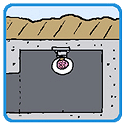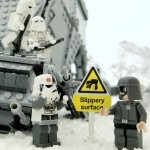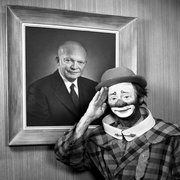|
Are there logistics trucks full of fuel and shells that hang behind the tanks, or do you have to return to base when you're out?
|
|
|
|

|
| # ? Jun 10, 2024 16:20 |
|
The Lone Badger posted:Are there logistics trucks full of fuel and shells that hang behind the tanks, or do you have to return to base when you're out? Something in between. Maneuver elements get tactical logistical units assigned, and when you need to load up you are rotated out of contact to a secluded area to meet up. It has always reminded me of F1-pitstops but with unstressed and overworked cynical conscripts instead. When you're on the move you keep an eye out for a good secluded place and if you you find something like that you radio that in. That continuously gives the logistics people a couple places to choose from. Mind, operational training and Peace Keeping are two different worlds. I guess acting as an
|
|
|
|
Re: Extra shells in a tank, you put them wherever you can without impeding the crew too much. Re:logistics/supply, in at least one of the Russian memoirs I have its mentioned multiple times that combat resupply did occur, even if it was with un-armoured trucks. The trucks in question would advance, under fire if need be, and an assistant driver/poor schmuc would pass shells off to the tank/spg/etc that needed it. Same goes for the Germans (in the memoir the tank commander shoots at least one supply truck in combat) and I wouldn't doubt for a second that other nations did so as well. That being said, you don't ever want to be near a supply truck if it gets hit
|
|
|
|
The thread title reminded me of a line I read in "1776" regarding the inebriation of (I think) Massachusetts soldiers besieging Boston.David McCullough's 1776 posted:A British ship's surgeon who used the privileges of his profession to visit some of the rebel camps, described roads crowded with carts and wagons hauling mostly provisions, but also, he noted, inordinate quantities of rum -- "for without New England rum, a New England army could not be kept together." The rebels, he calculated, were consuming a bottle a day per man. Now I'm not sure if the standardized Litre bottle had been widely adopted in The Colonies by 1775/1776 but a single bottle of rum per solider per day seems like an astounding amount of alcohol. I'm imagining a hungry revolutionary soldier consuming 1000 mL of 90-100 proof rum a day, and I don't see the man being in fitting state to fire a musket or do any kind of entrenching work. This could obviously be exaggeration by the "British ship's surgeon" or an embellishment of history but a battlefield of rummed-up American militiamen must have been a hosed up thing to command if everyone was completely wasted. Not to mention the logistical challenge of supplying an entire force with something like ~6 imperial gallons (27 litres) of rum per man per month. The quantity seems unlikely to me personally but paints an interesting picture of camp life and discipline in the American Revolutionary War era.
|
|
|
|
If there was a standardized bottle for liquor back then it was more likely a fifth of a gallon, which is just a bit over 750ml (if US gallons). Which is a possible amount to go through in a day and still function. Edit: that's "only" an average of, what, two beer/shot-equivalents per hour. They'd be beyond buzzed and well into tipsy depending on personal tolerance, but not too wasted to form up and fire a musket if the need arose. Chillbro Baggins fucked around with this message at 07:37 on Jun 13, 2017 |
|
|
|
The average consumption back then was triple today. People who drink a lot become able to drink a lot and function within certain parameters.
|
|
|
|
|
Asimov posted:The thread title reminded me of a line I read in "1776" regarding the inebriation of (I think) Massachusetts soldiers besieging Boston. War. War never changes.
|
|
|
|
There's a whole book on the subject of Colonial American drinking. And this little tidbit is probably in it: http://reason.com/archives/2014/02/22/george-washington-boozehound posted:Indeed, we still have available the bar tab from a 1787 farewell party in Philadelphia for George Washington just days before the framers signed off on the Constitution. According to the bill preserved from the evening, the 55 attendees drank 54 bottles of Madeira, 60 bottles of claret, eight of whiskey, 22 of porter, eight of hard cider, 12 of beer, and seven bowls of alcoholic punch.
|
|
|
|
We did this conversation recently. The bottles would have been closer to 300 ml.
|
|
|
|
|
And depending on the type of booze diluted upon destination.
|
|
|
|
Asimov posted:Now I'm not sure if the standardized Litre bottle had been widely adopted in The Colonies by 1775/1776 but a single bottle of rum per solider per day seems like an astounding amount of alcohol. I'm imagining a hungry revolutionary soldier consuming 1000 mL of 90-100 proof rum a day, and I don't see the man being in fitting state to fire a musket or do any kind of entrenching work. This could obviously be exaggeration by the "British ship's surgeon" or an embellishment of history but a battlefield of rummed-up American militiamen must have been a hosed up thing to command if everyone was completely wasted. Not to mention the logistical challenge of supplying an entire force with something like ~6 imperial gallons (27 litres) of rum per man per month. The quantity seems unlikely to me personally but paints an interesting picture of camp life and discipline in the American Revolutionary War era. The army isn't just soldiers, though. There are hundreds (and possibly thousands) of camp followers in the area. They're going to be drinking some of that alcohol. There's also a huge shortage of hard currency, so soldiers are bartering with each other (and merchants, etc.) for supplies and kit. Alcohol, being cheap, non-perishable, and universally popular, is a pretty decent thing to barter with.
|
|
|
|
Grand Prize Winner posted:Where would they put them? Just have shells loose on the turret floor? If you're the US during their entry to the war, apparently! Or on your lap or something.
|
|
|
|
I know that Navy Rum was pretty high test (95-115) but not sure whether the stuff that the militia were drinking was 80+. Cursory research didn't yield me anything.
|
|
|
|
It would make sense to keep alcohol higher proof until the end of the transportation chain, but I don't think I have any numbers in my booze books for before the 19th century. Bottle size (and all sorts of measures before standardization) make it challenging to accurately account consumption in a lot of cases, but there was a reason that temperance movements came about. Relative to modern times, people drank literally staggering amounts of alcohol in America in the 18th and 19th centuries.
|
|
|
|
Grand Prize Winner posted:Where would they put them? Just have shells loose on the turret floor? Anywhere they would fit. I've seen a photo of shells hanging outside the turret of an open-topped tank destroyer. BattleMoose posted:Would tank crews ever choose to not carry their full compliment of ammunition into battle, for having fewer things inside the tank that could explode? Real life isn't War Thunder. Anyway, the racks most at risk of being hit are also the quickest to access, so you're handicapping by not putting any ammo in them.
|
|
|
|
I'm gonna go out on a limb and say if the ammo racks of the turret are penetrated you have other concerns like the fragments flying everywhere that used to be the turret or the shell that just came to say hello.
|
|
|
spectralent posted:If you're the US during their entry to the war, apparently! Or on your lap or something. Not the US. The British had a tendency to cram way too much ammo into their Shermans (due to the extreme difficulty both sides had keeping the African front supplied), which is the source of the tank's only major period negative reputation. The US never adopted the practice, which is one of the reasons that it took as long as it did to improve the M4's ammo storage - when the tank was operated according to the manual, the problem didn't show up so much.
|
|
|
|
|
Can you recommend resources on the US military in the late 19th century? Roughly from the end of Reconstruction to the Spanish American war. I know very little about the Indian Wars, and nothing at all about the Navy at this time. It seems there's a huge leap in technology and tactics between the end of the Civil War and the start of the Spanish American war. Are there any good books detailing how that came about?
|
|
|
|
A question if anybody knows (somebody asked this in the AI thread): what kind of air defenses were there in North America in World War 2? I just know about my own neck of the woods. St. John's had light and heavy anti-aircraft batteries, as well as some [American-sourced] artillery at Cape Spear to deter snooping U-boats.
|
|
|
|
glynnenstein posted:It would make sense to keep alcohol higher proof until the end of the transportation chain, but I don't think I have any numbers in my booze books for before the 19th century. Yeah, documentaries of the temperance movement throw out figures for consumption that are absolutely shattering even by modern college standards, you can kind of see why a bunch of these people were wanting folks to drink less.
|
|
|
|
Bagheera posted:Can you recommend resources on the US military in the late 19th century? Roughly from the end of Reconstruction to the Spanish American war. tactics not so much, the smallest maneuver element is still the company in some cases and more frequently the battalion you can pretty much time travel officers from early 1700s through ~1900 and they'll be just fine.
|
|
|
|
Boiled Water posted:I'm gonna go out on a limb and say if the ammo racks of the turret are penetrated you have other concerns like the fragments flying everywhere that used to be the turret or the shell that just came to say hello. In a normal penetration (at least in WW2) on average you lose a crewman and maybe a limb. If the ammo cooks off though all the crew are burned alive with basically no chance to escape. There's a difference.
|
|
|
Fangz posted:In a normal penetration (at least in WW2) on average you lose a crewman and maybe a limb. If the ammo cooks off though all the crew are burned alive with basically no chance to escape. There's a difference. Taking the M4 Sherman and rounding the average casualty rate up to one, that means that most Shermans that were knocked out (note that official records do not appear to consider minor damage or knocked off tracks in this calculation) suffered no casualties at all. As there many ways for a tank to be taken out 100% casualties (all crewmen wounded or maimed), to get an average value of one you would need four tanks with no casualties (as the Sherman has a crew of 5, you would need a casualty rate of 0,0,0,0,5 to average out to one). At least, that is the mathematical assumption. I don't know how well supported it is by period sources.
|
|
|
|
|
You can knock out a tank without killing any crewmen at all, or you can kill some or all crewmen without disabling the tank.
|
|
|
|
KYOON GRIFFEY JR posted:tactics not so much, the smallest maneuver element is still the company in some cases and more frequently the battalion 'What's that lovely artillery piece with the teeny tiny barrel over there - it's a Maxim gun, you say? Doesn't look like it should be much threat'
|
|
|
|
I'm basing that off of my impression from memoirs, so I am not being very accurate. It will obviously depend on a lot of factors. My point is still that there's a large variety of things that can happen when a tank is hit, and things like wet stowage were a key concern to improve crew survivability.
|
|
|
|
Delivery McGee posted:There's a whole book on the subject of Colonial American drinking. Looking at historical data I'd expected to see a massive drop off in drinking behavior in the 1920s but the largest drop was by far in the 1830s. What happened then? The Second Great Awakening?
|
|
|
Fangz posted:I'm basing that off of my impression from memoirs, so I am not being very accurate. It will obviously depend on a lot of factors. My point is still that there's a large variety of things that can happen when a tank is hit, and things like wet stowage were a key concern to improve crew survivability. I wasn't saying you were wrong, but trying to expand on the point you were making.
|
|
|
|
|
zoux posted:Looking at historical data I'd expected to see a massive drop off in drinking behavior in the 1920s but the largest drop was by far in the 1830s. What happened then? The Second Great Awakening? Kids started getting drunk on revolution instead of booze
|
|
|
|
What could've Truman done differently in regards to handling China, Korea and Vietnam?
|
|
|
|
Grouchio posted:What could've Truman done differently in regards to handling China, Korea and Vietnam? I used to think the homework comments were a joke
|
|
|
|
nuke them all
|
|
|
|
Mazz posted:I used to think the homework comments were a joke
|
|
|
|
Grouchio posted:What could've Truman done differently in regards to handling China, Korea and Vietnam? he could have cast magic missile
|
|
|
|
Grouchio posted:What could've Truman done differently in regards to handling China, Korea and Vietnam? Allow them to embrace the glory of communism.
|
|
|
|
Hogge Wild posted:he could have cast magic missile 
|
|
|
|
Grouchio posted:I'm trying to make a CYOA thread, damnit. Don't forget Truman's handling of Laos, Cambodia, Malaysia, and the Manitoba Crisis.
|
|
|
|
Grouchio posted:What could've Truman done differently in regards to handling China, Korea and Vietnam? Gotten MacArthur killed in the Philippines somehow
|
|
|
|
FAUXTON posted:Gotten MacArthur killed in the Philippines somehow Sorry, no PT boats are available. SECWAR Stimson recommends you brush up on your Japanese.
|
|
|
|

|
| # ? Jun 10, 2024 16:20 |
|
Grouchio posted:I'm trying to make a CYOA thread, damnit. Are we keeping Truman's goals and knowledge? Like, if we did we'd probably do what he did. Not like the interventions were sure to succeed or sure to fail. What about a 1950 Alben W Barkley presidency, in the case of Torresola and Collazo succeeding? Gay Black Truman probably tells everyone to gently caress off, thus avoiding all three conflicts. He instead spends the money and troops razing the South to enforce desegregation Rockopolis fucked around with this message at 19:21 on Jun 13, 2017 |
|
|








 Bad Angus! Bad!
Bad Angus! Bad!































 Yes, it's like a lava lamp.
Yes, it's like a lava lamp.




